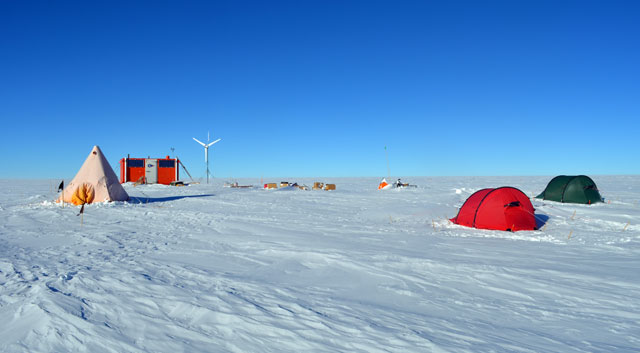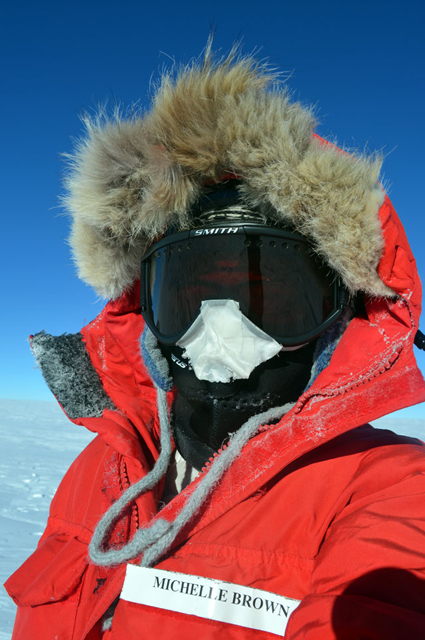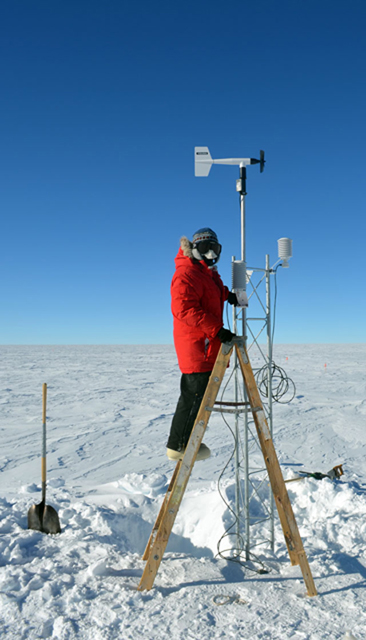Page 2/2 - Posted March 9, 2012
Frozen toothpaste and falling in love with AntarcticaTwo engineers from New Jersey Institute of Technology Michelle Brown's PolarTREC blogs
On Dec. 12, I took a small cargo plane to the Amundson-Scott South Pole Station. I was greeted by biting minus 20F temperatures and less oxygen than I was used to. The station sits at an elevation of 9,300 feet, most of it ice. The cold, dry air, combined with changes in ambient pressure, makes Antarctica’s altitude feel even higher on the lungs. There are many fascinating and unexpected scientific discoveries being made at the South Pole Station. I had time to learn about these experiments, since my plane was delayed for two weeks due to bad weather. I climbed into the South Pole Telescope After spending two weeks engrossed in the science at the station, we finally had good weather, and I prepared to leave with Bob, Andy, and our field coordinator, Susan Whitley. We flew 550 miles over a monotonous sheet of ice to land precariously on an un-groomed runway in the middle of nowhere. From my window, I could see a small orange box that stood out amongst an endless white landscape. The orange box is one of five space weather-monitoring stations in Antarctica known as an Automatic Geophysical Observatory (AGO) There is a fundamental relationship between magnetism and electricity, where a change in one affects a change in the other. Changes in Earth's magnetic field are largely caused by the sun. Charged particles (e.g., electrons and protons) escape the sun through solar wind that flows outward and hits Earth’s upper atmosphere. There, it creates electrical currents and changes Earth’s magnetism. Changes in the magnetic fields cause changes in the electricity on the ground. Pipelines, telephone lines and electricity lines can become charged with thousands of volts of current because of solar storms. Scientists fear that future solar events could severely damage satellites and other infrastructure if we don’t improve our understanding and ability to predict such events. The AGOs provide useful records of changes in the magnetic field and ionosphere. Bob and Andy are the MacGyvers of polar technology. Each year they return to the AGOs to replace, reset and update equipment. Given the remote locations of the AGOs, they cannot be perfectly prepared for all problems and are extremely resourceful. I once watched Andy improve the amplification of the Ham radio at the South Pole by using a part from an old television set! I was excited to spend a few days with these engineers at the AGO. After stepping out of the Twin Otter at AGO 4, wind chills of minus 35F beat against me, and after a few steps, I was already gasping for air. This was the Antarctica I had expected. Setting up a bathroom or sleeping tent became monumental achievements. Luckily there was refuge and hot cocoa inside the AGO. I was hesitant to go and sleep in my tent on the ice, but found it surprisingly warm. I awoke the next morning to find my toothpaste, along with other items, completely frozen. That was the moment I fell in love with Antarctica. I spent my second day at the AGO digging a five-foot trench to house an Automatic Weather Station (AWS) I installed the base of the AWS, which would record basic information about temperature, humidity, pressure, solar radiation, and wind speed and direction. When the plane came to drop off Andy and our cargo, I knew I had to get on it so I could return to Austin in time to teach. Plane delays are common in Antarctica, and if there’s a plane leaving, you’re best to take it! Leaving the AGO was difficult. I felt like I had finally encountered the harsh continent I had come to Antarctica to find. As I watched my frozen toothpaste thaw after leaving the field site, I knew my time in Antarctica had ended. Luckily, my Antarctic adventures inspired new lessons back in the classroom. I am constantly finding connections between what I learned in Antarctica with the lessons I am teaching. My experiences as a research assistant at McMurdo provide a model for teaching scientific methods to my students. Lessons about heat transfer or adaptations can now be taught through the lens of Weddell seals or Adélie penguins. Bob and Andy have inspired me to incorporate engineering and math into my teaching. They helped me create a video for my students that calculated the Earth’s tilt by measuring my height and shadow while at the South Pole on solstice. I am eager to build a Ham radio and seismometer (to measure earthquakes) in my classroom with their help. Lastly, I plan to teach students about space weather and the importance of monitoring changes in the Earth’s magnetic field. I feel extremely lucky to have been given the opportunity to travel to Antarctica and learn exciting science with researchers and engineers, but feel even luckier to experience this as a teacher, so that I can share what I have learned with my students and hopefully instill in them a wonder of science.Back 1 2 |



For USAP Participants |
For The Public |
For Researchers and EducatorsContact UsU.S. National Science FoundationOffice of Polar Programs Geosciences Directorate 2415 Eisenhower Avenue, Suite W7100 Alexandria, VA 22314 Sign up for the NSF Office of Polar Programs newsletter and events. Feedback Form |





